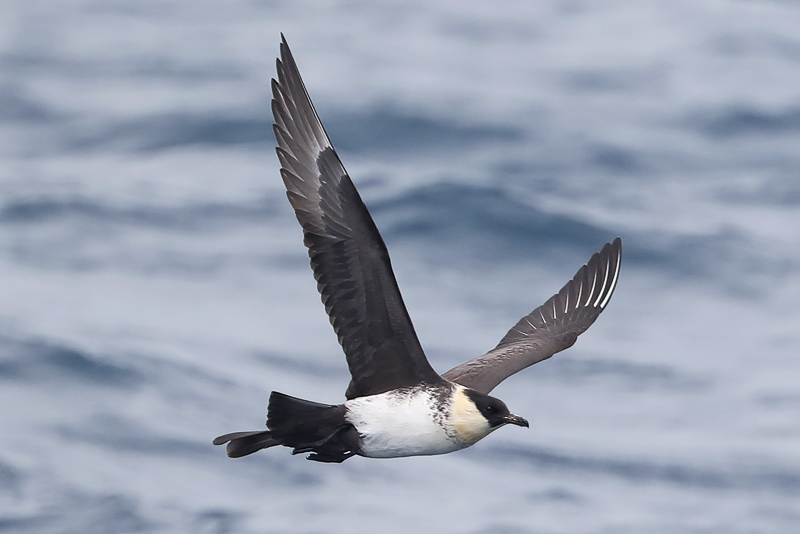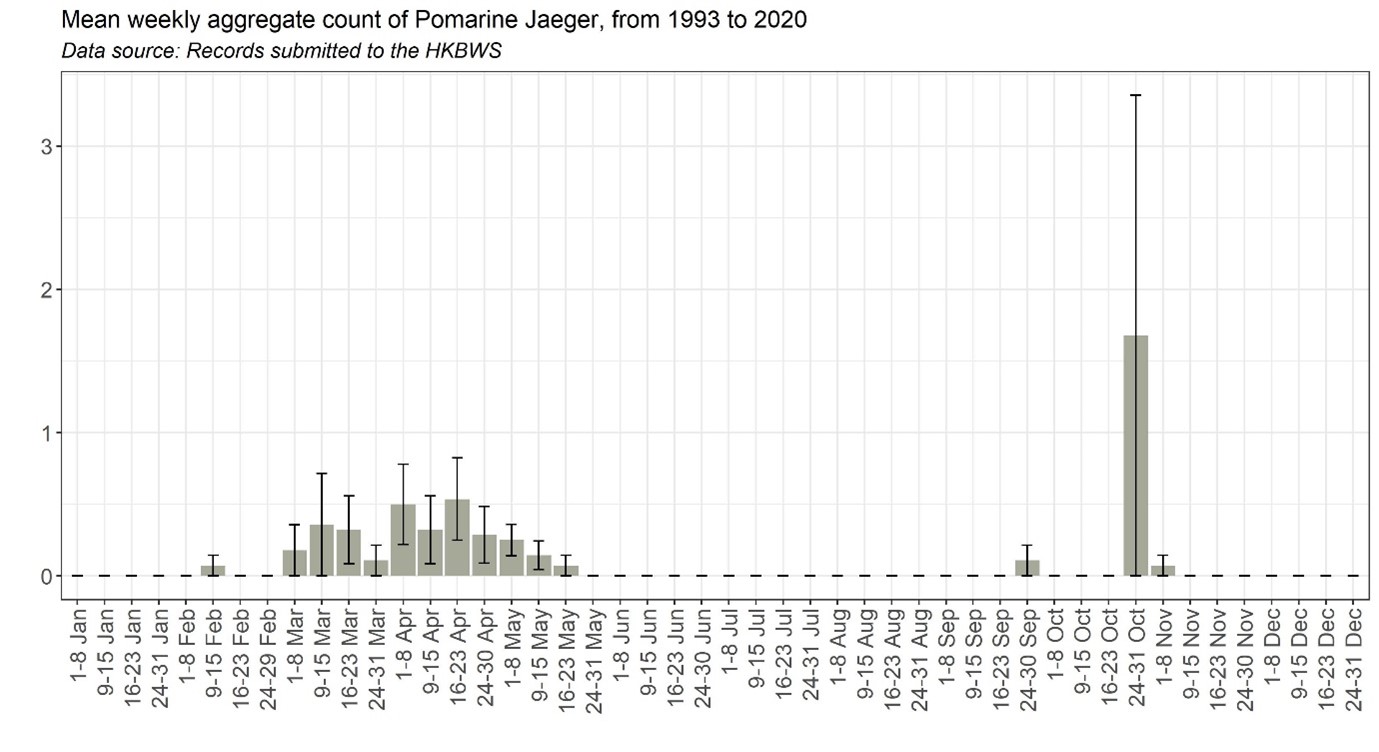Pomarine Jaeger Stercorarius pomarinus 中賊鷗
Category I. Rare passage migrant in spring, occasional storm-blown records in autumn and one winter record; occurs mainly in offshore waters.
IDENTIFICATION

Apr. 2018, Michelle and Peter Wong
42-50 cm (excluding tail streamers). The largest of the skuas recorded in HK. Steady, powerful flight, large body, rounded head profile and large bill.
The adult in breeding plumage (illustrated) has a broad and rounded central tail feather projection and dark brown heavily-spotted breast band. Males, as this bird appears to be, often do not have a complete breast band and show greater contrast with belly due to reduced flank marking. Compared to Parasitic Jaeger has more extensive cap and stronger yellow tone to neck sides. Pale morphs predominate.

Apr. 2014, Martin Hale.
Adult females tend to have broad complete breast band and more spotting on the flanks.
Juveniles are identified by structure and flight. Uppertail coverts are palest part of the upperparts, undertail coverts are barred, head is dark, the central tail feathers are short and rounded and both the bases to the primaries and the under primary coverts are pale creating a double pale band on the underwing.
For more detail on immature plumages see Olsen and Larsson (1997).
VOCALISATIONS
Generally, vocalises only on the breeding grounds, but an inflected ‘whyoo’ may be heard from birds at sea.
DISTRIBUTION & HABITAT PREFERENCE
All records have occurred at sea, mostly visible from Po Toi or boat-based observations in southern waters. There are four records from eastern waters from 10 February to 26 March, suggesting birds may occasionally winter in local seas.
OCCURRENCE
Figure 1 indicates that Pomarine Jaeger is largely a spring passage migrant through HK waters from March to mid-May with occasional autumn and winter records. The sole winter record occurred in eastern waters on 10 February. The next earliest records also occurred in eastern waters on 5th and 10 March. On spring passage, it occurs from the third week of March to the middle of May, with the latest record on 16 May 2008.
There are three autumn records, all seen from Cape D’Aguilar during close passage of tropical storms: three on 26 September 1993, the first HK record (Leader and Leven 1995), 47 (the highest recorded count in HK) on 26 October 1998 and two on 5 November 1993.
BEHAVIOUR, FORAGING & DIET
Generally seen on migratory flight over the sea, though occasionally chases terns.
RANGE & SYSTEMATICS
Monotypic. Near circumpolar breeding distribution north of the Arctic Circle excluding only Scandinavia and Greenland; winters at sea near coasts in southern hemisphere, subtropical northern hemisphere and northwest Europe (Haven Wiley and Lee 2020). In China it is a winter visitor to sea areas off the east and south coasts and there are scattered records inland (Liu and Chen 2020).
CONSERVATION STATUS
IUCN: Least Concern. Population trend stable.
Figure 1.

Haven Wiley, R. and Lee, D. S. (2020). Pomarine Jaeger (Stercorarius pomarinus), version 1.0. In Birds of the World (S. M. Billerman, Editor). Cornell Lab of Ornithology, Ithaca, NY, USA. https://doi.org/10.2173/bow.pomjae.01
Leader, P. J. and M. R. Leven (1995). Pomarine Skua: the first record for Hong Kong. Hong Kong Bird Report 1994: 113-114.
Liu, Y. and Y. H. Chen (eds) (2020). The CNG Field Guide to the Birds of China (in Chinese). Hunan Science and Technology Publication House, Changsha.
Olsen, K. M. and H. Larsson (1997). Skuas and Jaegers. A Guide to the Skuas and Jaegers of the World. Pica Press, Sussex.

